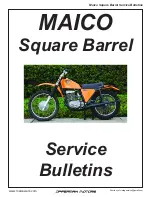
9
Safety
Safe Riding Practices
Carrying a Passenger
Do not carry a passenger
unless the motorcycle is equipped with passenger seat and passen-
ger footrests.
To carry a passenger safely:
• Do not exceed the gross vehicle weight rating (GVWR) for your motorcycle.
• Direct the passenger to hold onto you or to the passenger hand grips with both hands and
to keep both feet on the passenger footrests. Do not carry a passenger who cannot place
both feet firmly on the passenger footrests. A passenger who is not holding on properly, or
who cannot reach the passenger footrests, can shift their body erratically, which can make
the motorcycle hard to handle and cause loss of control.
• To obtain the best ride and handling characteristics, adjust the rear shock absorber air pres-
sure. See page 64.
• Before riding, be sure your passenger knows safe riding procedures. Discuss any safety
information unfamiliar to your passenger. A passenger who is unaware of safe riding pro-
cedures may distract you or make movements that make the motorcycle hard to handle.
• Adjust your riding style to compensate for the differences in handling, acceleration and
braking caused by the additional weight of the passenger. Failure to do so can cause loss of
control.
Protective Apparel
Wear protective apparel to decrease the risk of injury and increase riding comfort.
• Always wear a helmet that meets or exceeds established safety standards. Approved hel-
mets in the USA and Canada bear a U.S. Department of Transportation (DOT) label. Laws
in some areas
require
that you wear an approved helmet. Head injuries are the leading
cause of fatalities in accidents involving motorcycles. Statistics prove that an approved
helmet is the most effective protection in preventing or reducing head injuries.
• Wear eye protection to protect eyes from wind or airborne particles and objects. Laws in
some areas
require
that you wear eye protection. VICTORY recommends that you wear
approved Personal Protective Equipment (PPE) bearing markings such as VESC 8, V-8,
Z87.1, or CE. Make sure protective eyewear is kept clean.
• All riders should wear bright or light-colored and/or reflective clothing to improve visibil-
ity to other motorists.
A motorist's failure to see or recognize a motorcycle is the leading
cause of automobile/motorcycle accidents.
• Wear gloves, a jacket, heavy boots and long pants to prevent or reduce injury from abra-
sions, lacerations or burns should the motorcycle fall. Wear boots with low heels, as high
heels can catch on pedals or footrests. The combination of boots and pants should com-
pletely cover legs, ankles and feet, protecting skin from engine and exhaust system heat.
• Do not wear loose, flowing clothing or long boot laces, as they can catch on handlebars,
levers or footrests, or they can become entangled in the wheels, causing loss of control and
serious injury.
Summary of Contents for 2011 Cross Country
Page 1: ...PMS 419 2011 Rider s Manual Victory Cross Country TM Victory Cross RoadsTM...
Page 3: ...The text is printed on 100 recycled with 40 post consumer waste PCW...
Page 5: ...1 2011 Rider s Manual Victory Cross Roads Victory Cross Country...
Page 60: ...56 Maintenance Maintenance Log Maintenance Performed Miles Km Notes Performed by...














































